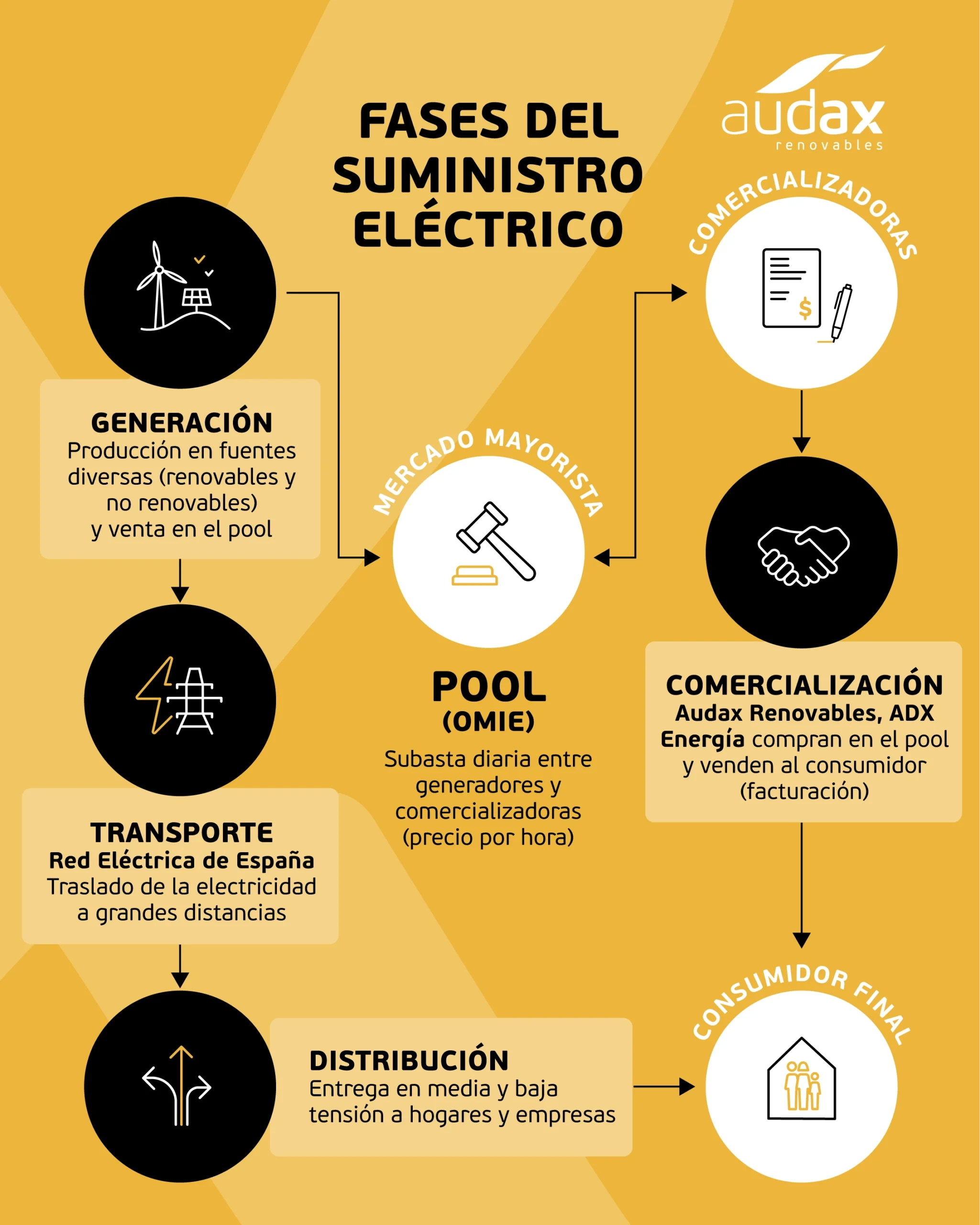How does the electricity market work and who are the main players?
Energy generation, supply, and investment: a clear view of how the electricity market works
Understanding the electricity journey from its source to its delivery to homes and businesses is essential for understanding the energy sector and making informed decisions about our supply. Below, we'll detail the phases of electricity supply, the functioning of the wholesale market, and investment in renewable energy, highlighting Audax Renovables' role as an energy company.
How does electricity generation and distribution work?
The supply of electricity to the final consumer comprises four main and distinct phases in the value chain:
1. Energy generation:
It is the starting point where electrical energy is produced in various facilities (wind and photovoltaic farms, hydroelectric plants, combined cycle plants, nuclear power plants, etc.).
2. Electricity transport:
It involves the transfer of electricity over long distances through the high voltage network, operated by Spanish Electricity Grid, which acts as the backbone infrastructure of the system.
3. Power distribution:
This is the channeling of energy through medium- and low-voltage networks to final consumption points. Distribution companies own this capillary network in assigned geographic areas and guarantee physical delivery. Examples of distributors include Endesa, Iberdrola, and Naturgy.
4. Electricity marketing:
Marketing companies such as Audax Renovables or ADX Energy They buy energy on the wholesale market and sell it to the end consumer, managing contracts, billing and service.
The wholesale electricity market (pool)
Electrical energy, in its essence, works as a commodity, a commodity whose price is set on a specific market. The main one is the daily market or "pool", managed by OMIE, the electricity market operator designated to manage the daily electricity market in the Iberian Peninsula, known as NEMO (Nominated Electricity Market Operations) at the European level.
In this regulated market, generators bid on their production, and retailers purchase the energy needed to supply their customers through a daily auction, priced hourly and varying according to supply and demand. The result is a "clearance price," which determines the energy's value for each hour of the day. This daily price is the fundamental reference for the cost of energy in the wholesale market.
Investment in Renewable Energy: Keys and Metrics
Investing in new generation plants, especially renewable ones, involves significant economic considerations. For reference, Marc Farriol, Managing Director of Power Generation at Audax Renovables, indicates that the construction cost (CAPEX) is typically estimated at euros per megawatt (MW) of installed capacityHe points out that "a wind farm can cost around €1,000,000 or €1,200,000 per MW installed, while photovoltaic power is somewhat cheaper, perhaps around €800,000/MW," adding that these are orders of magnitude and depend on multiple factors.
In this sense, it is vital to distinguish between:
- Power (MW): the maximum instantaneous generating capacity of a plant.
- Energy (MWh or GWh): the total amount of electricity produced in a given time (result of Power x Hours of effective operation).
Illustrating this, Marc Farriol explains that "a 50 MW wind farm, if operated for approximately 2,000 hours per year, would generate 100,000 MWh (or 100 GWh) of energy annually." This generated energy is then sold on the market or through bilateral contracts.
Audax Renovables: Own generation and marketing
Within this complex electrical system, Audax Renovables operates strategically in two key areas:
1. Own generation 100% renewable:
Audax not only markets, but also invests in and operates its own generation plants, exclusively from renewable sources (mainly wind and photovoltaic). This vertical integration It allows us to generate clean energy and use "part of the energy we sell to our customers directly from our facilities." The energy generated is fed into the system, either by selling it on the market (pool) or through bilateral contracts (PPA), often with our own marketing companies. ADX Energy either Audax Renewables.
2. Efficient and flexible marketing:
As a marketer, our role at Audax and ADX Energía is to acquire the energy our customers need (from the pool, PPAs, or our own generation) and supply it to them in the most advantageous and tailored way. This involves:
2.1. Purchase management:
We operate in wholesale and futures markets to ensure supply at the best possible cost.
2.2 Network access:
We manage and cover toll costs for the use of the transportation and distribution networks.
2.3. Electricity rates:
We offer various contractual modalities:
- Fixed electricity price : for customers seeking predictability and stability in their energy costs.
- Indexed price of electricity: directly linked to hourly wholesale market prices, plus a small management margin, ideal for those who can adapt to volatility.
- Mixed and customized solutions: combining the above to optimize according to the consumption profile.
- Clear billing and customer care: We issue detailed invoices and offer customer service to resolve queries and facilitate procedures tailored to each client's needs.
Audax Renovables acts as a essential bridge Between the complexity of the energy market and the needs of the end consumer. We provide added value not only by managing supply and associated costs, but also by offering contractual flexibility and a firm commitment to renewable energy, simplifying access to sustainable and competitive energy.





